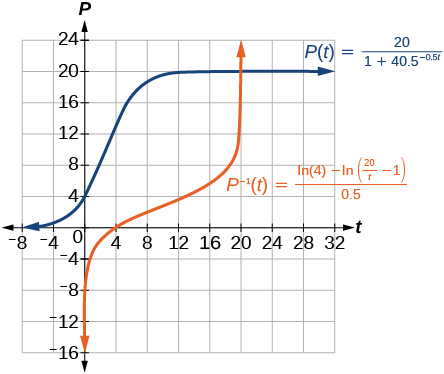| << Chapter < Page | Chapter >> Page > |
Use a graphing utility to find an exponential regression formula and a logarithmic regression formula for the points and Round all numbers to 6 decimal places. Graph the points and both formulas along with the line on the same axis. Make a conjecture about the relationship of the regression formulas.
Verify the conjecture made in the previous exercise. Round all numbers to six decimal places when necessary.
First rewrite the exponential with base e : Then test to verify that taking rounding error into consideration:
Find the inverse function for the logistic function Show all steps.
Use the result from the previous exercise to graph the logistic model along with its inverse on the same axis. What are the intercepts and asymptotes of each function?

The graph of has a y -intercept at (0, 4) and horizontal asymptotes at y = 0 and y = 20. The graph of has an x - intercept at (4, 0) and vertical asymptotes at x = 0 and x = 20.
Determine whether the function represents exponential growth, exponential decay, or neither. Explain
exponential decay; The growth factor, is between and
The population of a herd of deer is represented by the function where is given in years. To the nearest whole number, what will the herd population be after years?
Find an exponential equation that passes through the points and
Determine whether [link] could represent a function that is linear, exponential, or neither. If it appears to be exponential, find a function that passes through the points.
| x | 1 | 2 | 3 | 4 |
| f(x) | 3 | 0.9 | 0.27 | 0.081 |
A retirement account is opened with an initial deposit of $8,500 and earns interest compounded monthly. What will the account be worth in years?
Hsu-Mei wants to save $5,000 for a down payment on a car. To the nearest dollar, how much will she need to invest in an account now with APR, compounded daily, in order to reach her goal in years?
Does the equation represent continuous growth, continuous decay, or neither? Explain.
continuous decay; the growth rate is negative.
Suppose an investment account is opened with an initial deposit of earning interest, compounded continuously. How much will the account be worth after years?
Graph the function State the domain and range and give the y -intercept.
domain: all real numbers; range: all real numbers strictly greater than zero; y -intercept: (0, 3.5);

Graph the function and its reflection about the y -axis on the same axes, and give the y -intercept.
The graph of is reflected about the y -axis and stretched vertically by a factor of What is the equation of the new function, State its y -intercept, domain, and range.
y -intercept: Domain: all real numbers; Range: all real numbers greater than

Notification Switch
Would you like to follow the 'Algebra and trigonometry' conversation and receive update notifications?